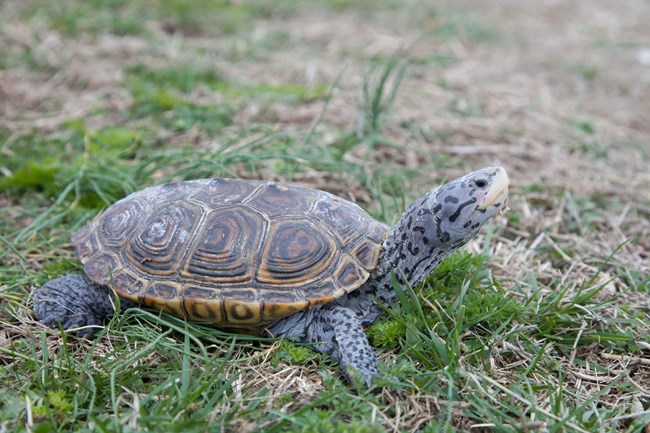
The main reason that terrapins are seldom seen is because they are turtles of the saltmarsh, where people rarely venture save for fishermen. But they are a fairly widespread species that inhabit marshes, estuaries, and tidal creeks from Massachusetts to Texas. In completely scientific terms, they are cool looking, with striking off-white skin speckled with black dots. Their shells can range from black to green to orange with gradations in between, and the scutes (sections) of their carapaces (upper shells) are raised like little knobs along the surface in older individuals. The males are smaller than the females, which can grow up to eleven inches in length. Both sexes are strong swimmers since their habitat is a place of strong currents and daily tide changes. As such they have been honed by evolution with webbed feet and particularly large hind feet to propel them through the water. Though they live in the marsh, when it comes time to lay eggs the female seeks out relatively dry, sandy areas in which to dig a nest and deposit her eggs. Park staff have by chance seen this happen in summer months in very close proximity to Fort Matanzas itself! Though at least one nest was depredated by raccoons, another nest survived and staff were able to confirm a curious trait of the terrapin- overwintering (or delayed emergence). This is when the eggs hatch in the fall as expected but the hatchlings remain in the nest until the following spring! Terrapins are not unique in exhibiting this behavior, and research indicates it may be a more common trait than previously thought in the turtle world. But overwintering in a natal nest isn’t as odd as it seems when you consider that turtles are cold-blooded reptiles. When their body temperatures reach about 45 degrees F., they become sluggish, stop eating, and go into hibernation mode. For adult terrapins this means burying themselves in mud at the bottom of marsh creeks for the winter. Though their metabolic rates are extremely reduced during this time they still need to breathe, albeit to a very limited extent. They do this by absorbing dissolved oxygen from the water that permeates the surrounding mud through their mouth and cloaca. When they emerge from hibernation in early spring, it is time to mate and eat. A terrapin’s usual prey consists of: snails, crabs, mussels, clams, fish, worms, insects, and carrion. In terms of what in turn eats adult terrapins, raccoons are what they mostly need to watch out for. Hatchlings and eggs face a greater roster of predators: crabs, crows, gulls, herons, rats, foxes, minks, and (of course) raccoons. Because of predation and the risk of flooding, survival rates for nests and hatchlings tend to be low. (A nest can contain from five to twenty eggs, and the female will lay two to three clutches per year.) Between flooding events and a long list of predators, terrapins as a species already faced challenges before human populations and development along the coasts started exploding. Now terrapin populations have been reduced by illegal human harvesting for their meat and for the pet trade, destruction of their habitats as wetlands are drained and filled, being hit by speeding boats, and by getting trapped in crab pots that don’t possess turtle excluder devices. As usual, parks and other protected lands have an important role to play by protecting habitat upon which terrapins rely, and by educating the public about this rarely seen but nonetheless important and interesting turtle of the marshlands. |
Last updated: March 9, 2021
